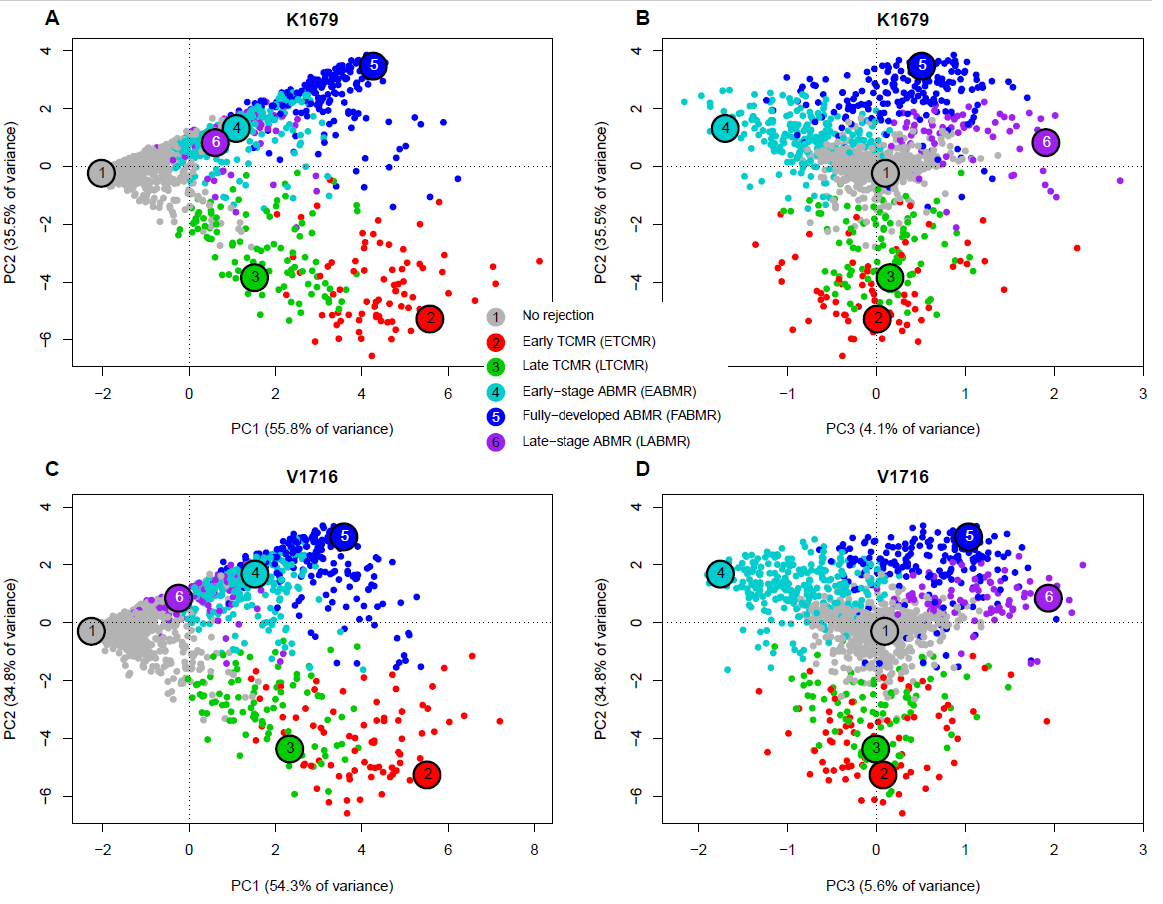Reassessing TCMR in Kidney Transplant Indication Biopsies: Emerging Evidence for Partial Exhaustion in Late TCMR
1Alberta Transplant Applied Genomics Centre, Edmonton, AB, Canada, 2., ., AB, Canada
Meeting: 2021 American Transplant Congress
Abstract number: 236
Keywords: Kidney transplantation, Rejection, T cell activation, Tolerance
Topic: Clinical Science » Kidney » Kidney: Acute Cellular Rejection
Session Information
Session Name: Kidney: Acute Cellular Rejection
Session Type: Rapid Fire Oral Abstract
Date: Monday, June 7, 2021
Session Time: 4:30pm-5:30pm
 Presentation Time: 4:45pm-4:50pm
Presentation Time: 4:45pm-4:50pm
Location: Virtual
*Purpose: We rederived the MMDx rejection archetypes in an expanded set of 1679 kidney transplant biopsies to add power and potentially define heterogeneity in TCMR. We repeated the same analysis in 1716 other biopsies to examine the stability of the classification in an independent set. We were particularly interested in whether T cell exhaustion impacted the TCMR phenotype with increasing time post-transplant.
*Methods: We analyzed rejection in microarray results from 1679 kidney transplant indication biopsies using seven machine learning derived rejection classifiers following the same strategies used previously (Am J Transplant. 2019;19:2719).
*Results: The scores assigned each biopsy a position in data space when distributed by principal component analysis (PCA) as 4 PCs (Figure 1A). Archetype analysis assigned six rejection archetypes (clusters) for both populations, which were very similar: 1: No rejection; 2: early TCMR (ETCMR): 3: late TCMR (LTCMR); 4: early stage ABMR (EABMR); 5: fully-developed ABMR (FABMR); and 6: late-stage ABMR (LABMR).
The principal components of variation in rejection-ness were PC1: no rejection vs. rejection; PC2: ABMR+ vs TCMR -ve; PC3: stages of ABMR (EABMR, FABMR, LABMR); and PC4: stages of TCMR: ETCMR and LTCMR. (PC4 cannot be visualized.) Mixed rejection had varying components of ABMR and TCMR.
The assignment of archetype groups was validated in an independent set of 1716 biopsies, indicating high conservation of the new rejection classification (Figure 1C,D).
The new LTCMR class differed from ETCMR in being later post-transplant (median 506 vs. 258 days), with lower PC1 scores and more histologic and molecular atrophy-fibrosis. Compared to ETCMR, LTCMR had less intense activation signals (e.g. CCL5) and T cell receptor expression. In 24 BK nephropathy with TCMR, 21 were LTCMR. Failures were increased by both ETCMR and LTCMR.
The principal feature that separated ETCMR and LTCMR was principal component 4 (PC4): ETCMR +0.63; LTCMR -0.67. PC4 distinguished a reciprocal relationship between TCMR activity features (e.g. CCL5 correlation -0.387) and a major checkpoint, PD1 (PDCD1): correlation +0.104. All five PD1 probesets anti-correlated with TCMR activity features, suggesting that LTCMR has more T cell exhaustion than ETCMR.
*Conclusions: An expanded PCA and archetype analysis recognizes a new class of late TCMR that separates in PC4 from early TCMR and has more fibrosis, less activity, and a reciprocal relationship between checkpoint PD1 and TCMR activity, suggesting a time-dependent increase in T cell exhaustion.
To cite this abstract in AMA style:
Halloran P, Reeve J. Reassessing TCMR in Kidney Transplant Indication Biopsies: Emerging Evidence for Partial Exhaustion in Late TCMR [abstract]. Am J Transplant. 2021; 21 (suppl 3). https://atcmeetingabstracts.com/abstract/reassessing-tcmr-in-kidney-transplant-indication-biopsies-emerging-evidence-for-partial-exhaustion-in-late-tcmr/. Accessed December 23, 2025.« Back to 2021 American Transplant Congress

